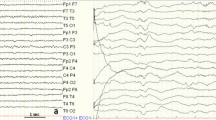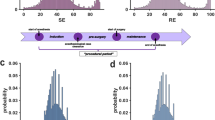Abstract
The aim of the study was to distinguish Benign Focal Epilepsy of Childhood with Occipital Paroxysms (BEOP) from its symptomatic counterpart on the basis of the location of the sources of the interictal EEG spikes. Patients were classified into two groups: idiopathic BEOP and symptomatic occipital lobe epilepsy. Source analysis of the averaged occipital spikes was performed using a homogeneously conducting sphere as the volume conductor model. Results showed a statistically significant difference in the eccentricity, i.e., the distance of the occipital spike focus from the centre of the head. The dipole sources of the occipital spikes in the BEOP group were found to be located more superficially than in the symptomatic group, corresponding in six of the nine cases with a source position estimated to be within the cortical layer just below the skull. The eccentricity of the symptomatic occipital spikes suggests a location deeper than the cortical layer. The results were validated in two patients from the symptomatic group. In one patient the estimated deeper dipole source location corresponded with a deeper location of spike activity observed during ECoG; in the other patient's ECoG, spike activity was observed superficially but over an extended area. The discrepancy between estimated and real location may be explained by the method of dipole source analysis used. It is concluded that the finding of a superficial dipole source location of the occipital spikes provides an indication for the diagnosis BEOP (sensitivity: 67%; specificity: 74%).
Similar content being viewed by others
References
Ary, J.P., Klein, S.A. and Fender, D.H. Location of sources of evoked scalp potentials: corrections for skull and scalp thicknesses. Biomed., Eng. 1981, 28(6): 447–452.
Aso, K., Watanabe, K., Negoro, T., Takaesu, E., Furune, A., Takahashi, I., Yamamoto, N. and Nomura, K. Visual seizures in children. Epilepsy Res., 1987, 1: 246–253.
Baumgartner, Ch., Graf, M., Doppelbauer, A., Serles, W., Lindinger, G., Olbrich, A., Bacher, J., Pataraia, E., Almer, G. and Lischka, A. The functional organization of the interictal spike complex in Benign Rolandic Epilepsy. Epilepsia, 1996, 37: 1164–1174.
Buchsbaum, M.S., Hazlett, E., Sicotte, N., Ball, R. and Johnson, S. Geometric and scaling issues in topographic electroencephalography. In: FH Duffy, ed. Topographic mapping of brain electrical activity. Butterworths, 1986: 325–337.
Chatrian, G.E., Lettich, E. and Nelson, P.L. Ten percent electrode system for topographic studies of spontaneous and evoked EEG activities. Am. J. Electroencephalogr. Technol., 1985, 25: 83–92.
Cooper, G.W. and Lee, S.I., Reactive occipital epileptiform activity: is it benign? Epilepsia, 1991, 32(1): 63–68.
Dalla Bernardina, B., Fontana, E., Cappellaro, O., Zullini, E., Darra, F., Colamaria, V. and Caraballo, R. The partial occipital epilepsies in childhood. In: F. Andermann, A. Beaumanoir, L. Mira, J. Roger and C.A. Tassinari (eds.). Occipital seizures and epilepsies in children. London; John Libbey, 1993: 173–182.
Dalla Bernardina, B., Fontana, E., Cappalaro, E., Santorum, E., Piardi, F., Avesani, E. and Montagnini, A. Partial occipital epilepsies in childhood: electroclinical study of 100 patients. Epilepsia, 1995, 36: S92.
De Munck, J.C. The estimation of time varying dipoles on the basis of evoked potentials. Electroenceph. clin. Neurophysiol., 1990, 77: 156–160.
Gastaut, H. A new type of epilepsy: benign partial epilepsy of childhood with occipital spike-waves. Clin. Electroencephalogr., 1982, 13(1): 13–22.
Gastaut, H. Benign epilepsy of childhood with occipital paroxysms. In: J. Roger, Ch. Dravet, F.E. Dreifuss, A. Perret and P. Wolf (eds.). Epileptic syndromes in infancy, childhood and adolescence. 2nd edition. London: John Libbey and Company Ltd., 1992: 201–217.
Jasper, H.H., The ten-twenty electrode system of the International Federation. In: The International Federation of Societies for Electroencephalography and Clinical Neurophysiology. Recommendations for the practice of Clinical Neurophysiology. Amsterdam: Elsevier, 1983: 3–9.
Maher, J., Ronen, G.M., Ogunyemi, A.O. and Goulden, K.J. Occipital paroxysmal discharges suppressed by eye opening: variability in clinical and seizure manifestations in childhood. Epilepsia, 1995, 36(1): 52–57.
Nalin, A., Ruggerini, C., Ferrari, E., Galli, V., Ferrari, P. et Finelli, T. Clinique, diagnostic differentiel et evolution des crises epileptiques visuelles de l'enfant. Neurophysiologie Clinique, 1989, 19: 25–36.
Talwar, D., Rask, C.A. and Torres, F. Clinical manifestations in children with occipital spike-wave paroxysms. Epilepsia, 1992, 33(4): 667–674.
Terasaki, T., Yamatogi, Y. and Ohtahara, S. Electroclinical delineation of occipital lobe epilepsy in childhood. In: F. Andermann and E. Lugaresi, eds. Migraine and Epilepsy. Stoneham: Butterworth Publishers, 1987: 125–138.
Van Drongelen, W., Yuchtman, M., Van Veen, B.D. and Van Huffelen, A.C. A spatial filtering technique to detect and localize multiple sources in the brain. Brain Topogr., 1996, 9(1): 39–49.
Van der Meij, W., Van Huffelen, A.C., Willemse, J., Schenk-Rootlieb, A.J.F. and Meiners, L.C. Rolandic spikes in the interictal EEG of children. Contribution to diagnosis, classification and prognosis of epilepsy. Dev. Med. Child Neurol., 1992, 34: 893–903.
Van der Meij, W., Van Huffelen, A.C., Wieneke, G.H. and Willemse, J. Sequential EEG mapping may differentiate ‘epileptic’ from ‘non-epileptic’ rolandic spikes. Electroenceph. clin. Neurophysiol., 1992, 82(6): 408–414.
Van der Meij, W., Wieneke, G.H., Van Huffelen, A.C. Dipole source analysis of rolandic spikes in Benign Rolandic Epilepsy and other clinical syndromes. Brain Topogr., 1993, 5: 203–213.
Weinberg, H., Wong, P.K.H., Crisp, D., Johnson, B. and Cheyne, D. Use of multiple dipole analysis for the classification of Benign Rolandic Epilepsy. Brain Topogr., 1990, 3(1):183–189.
Author information
Authors and Affiliations
Rights and permissions
About this article
Cite this article
Van der Meij, W., Van der Dussen, D., Van Huffelen, A.C. et al. Dipole Source Analysis May Differentiate Benign Focal Epilepsy of Childhood with Occipital Paroxysms from Symptomatic Occipital Lobe Epilepsy. Brain Topogr 10, 115–120 (1997). https://doi.org/10.1023/A:1022299610769
Issue Date:
DOI: https://doi.org/10.1023/A:1022299610769




